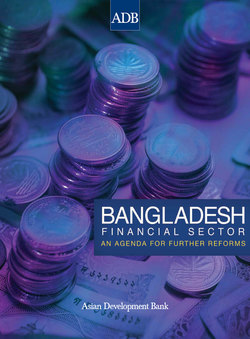Читать книгу Bangladesh Financial Sector - Syed Ali-Mumtaz H. Shah - Страница 6
На сайте Литреса книга снята с продажи.
Introduction
ОглавлениеThe economy of Bangladesh has been growing steadily. Real gross domestic product (GDP) grew at an average rate of 5.8% per annum during 2000–2009, compared with 5.5% in 1995–2009. The GDP annual growth rate reached 5.9% in FY2009, down from 6.2% in FY2008. The deep and prolonged recession in the United States and Europe from the 2008 financial crisis adversely affected GDP growth in FY2009 (see discussion under Macroeconomics Environment).1 From 1991 to 2005, the national poverty incidence fell from 59% to 40%. Efforts to overcome poverty face numerous constraints, including the urgent need for strong law and order, good infrastructure, sound and efficient financial markets, high-quality social services that are accessible and affordable, and an enabling environment for private sector development.
The government’s National Poverty Reduction Strategy2 reaffirms that poverty reduction and accelerating the pace of social development are Bangladesh’s most important long-term strategic goals. The development of the financial sector is critical for meeting the twin goals of economic growth and poverty reduction since the financial sector mobilizes resources and allocates them to those investments that are capable of generating the highest return on capital. The better the financial sector can fulfill this role, the better the economy will perform in the long run. Financial sector development can benefit the poor by: (i) promoting overall economic growth, which in turn leads to improved income levels overall, and (ii) reducing the risk of financial crises, whose adjustment costs are most felt by the poor improving access of the poor to financial services.
In recognition of the strategic importance of the financial sector in reducing poverty, the Financial Sector Strategy study for Bangladesh has been prepared to take stock of and map the required initiatives over the medium to long term. The study will guide future operations of the Asian Development Bank (ADB) in this sector in the context of the overarching poverty reduction objective of the government and ADB. The study provides an assessment of how the financial sector can help create a better environment for growth, employment, and investment and help reduce poverty. It also takes into account the political realities and identifies reforms and measures that have not yet been addressed.
